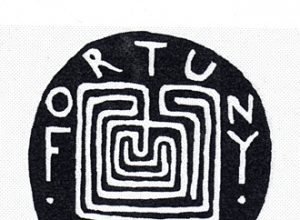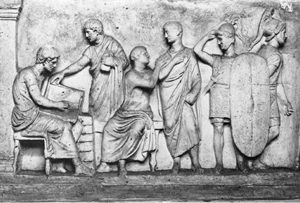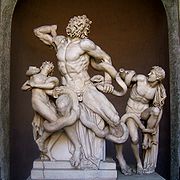
One must go back to Ancient Rome in order to study the burgeoning relationships between art and society at a time when images had already become the dominant means of expression. Valérie Naas offers us a valuable critical appreciation of Pliny the Elder’s Natural History, a key source on ancient art. She thus reveals the role art-as-war-booty played for the victors who had brought countless statues back to Rome.
Alexandre Grandazzi emphatically shows how original was the framework within which these transfers took place, and he also brings out the political impact of this form of art that was not yet so named. The Romans carried off the masterpieces of Greece, but also and especially they brought back with them a model, stealing thereby from the vanquished their creative powers while admiring them to the point of imitating their style and making a host of copies. By imposing a new context and new edifying figures on this largely borrowed form of art, the Romans conferred upon it a new role as a unifier for an empire that was destined to promote “the Roman way of life.”
Laurence Bertrand Dorléac
Pliny the Elder
and the Rediscovery
of Classical Art
During the Renaissance
Valérie Naas
Pliny the Elder and the Rediscovery of Classical Art During the Renaissance
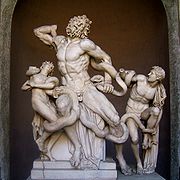
Laocoon, Musée Pio Clementino, Vatican., inv. 1059, 1064, 1067.
In 1506, Laocoön, a group sculpture representing a famous episode during the Trojan War, was unearthed in Rome. The Trojan priest and his two sons are shown being crushed to death by serpents sent by the gods favoring the Greeks to prevent Laocoön from warning his compatriots about the “Trojan horse.”
The Humanists of the Renaissance immediately identified this major archeological find as the work extolled by Pliny the Elder in his Natural History (36.37):
“. . . the Laocoön, for example, in the palace of the Emperor Titus, a work that may be looked upon as preferable to any other production of the art of painting or of statuary. It is sculptured from a single block, both the main figure as well as the children, and the serpents with their marvelous folds. This group was made in concert by three most eminent artists, Agesander, Polydorus, and Athenodorus, natives of Rhodes.”
Coveted by Francis I, the Laocoön Group was acquired by Pope Julius II, who exhibited it at his Cortile del Belvedere alongside such other great antiquities as the Apollo Belvedere and the Belvedere Torso. This sculpture has inspired numerous artists down through the centuries, such as Peter Paul Rubens, El Greco, Ossip Zadkine, and Étienne Bossut.
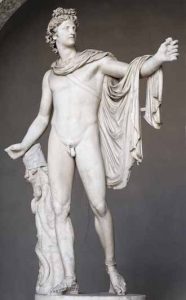
Belvedere Apollo, Musée Pio Clementino, Vatican, inv. 1015.
The linking of archeological discoveries to Pliny’s text greatly contributed to the progress being made in Renaissance art, as Vasari testifies:
“The artisans who followed them succeeded after seeing the excavation of the most famous antiquities mentioned by Pliny: the Laocoon, the Hercules, and the great torso of Belvedere, the Venus, the Cleopatra, the Apollo, and countless others, which exhibit in their softness and hardness the expressions of real flesh copied from the most beautiful details of living models and endowed with certain movements which do not distort them but lend them motion and the utmost grace. And these statues caused the disappearance of a certain dry, crude, and clear-cut style which was bequeathed to this craft.”
Yet, beyond the artistic creativity thus inspired, there was also a reflection on art that leaned on a reading of Pliny: “Pliny was to be found on Wincklemann’s table and his patterns of interpretation had already deeply influenced the artistic literature of Humanism, beginning with Lorenzo Ghiberti,” writes the historian of Roman Art Salvatore Settis.
Pliny the Elder, A High Official in the Service of Knowledge
Pliny the Elder (23-79) was a top-ranking official of the Roman Empire, close to the Flavian emperors, who wrote accounts in various fields (history, art of warfare, the Latin tongue). His final work, the only one preserved in its entirety, is an encyclopedia of nature, the Natural History (Naturalis Historia) in thirty-seven books devoted to the following fields: the world, man, animals, plants, remedies drawn from animal and plant substances, and mineralogy. This final part contains digressions on art history, which is treated as a way of developing or exploiting materials that exist in nature (metals and stones for sculpture, soils for painting). For Pliny, the history of art appears as a peripheral subject and is treated without any continuity.
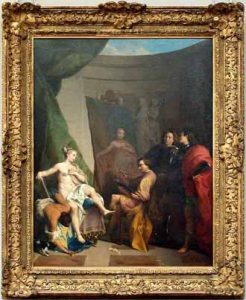
Nicolas Vleughels: Apelle peignant Campaspe, 1716, Musée du Louvre, inv. 8482.
Despite this, and given the loss of the prior texts, Pliny constitutes a source of prime importance on ancient art, in particular classical Greek art. He also relates a great many anecdotes about artists, which have nourished both artistic productions (for example, François-André Vincent’s Zeuxis Choosing Models from the Beautiful Women of Croton and Nicolas Vleughels’s Apelles Painting Campaspe) and the biographical approach that presided in art history until Wincklemann (in particular with Giorgio Vasari’s Lives of the Most Excellent Painters, Sculptors, and Architects, 1550).
The Cyclical (Biological) Conception of Art and Its Descendants
Pliny handed down the main way of reflecting about art in Antiquity, as was applied to art by the bronze-founder and art theorist Xenokrates of Sicyon (fl. c. 280 BCE). This was a cyclical model, also called biological, according to which art follows the arc of living things, with a birth, growth, an apogee, decline, and death.
This pattern of thinking was gradually taken up again during the Renaissance, in particular by Dante, Petrarch, Ghiberti, Leon Battista Alberti, and Vasari (the biological model was applied at the time to literature as well as art). In the eighteenth century, it was also followed by Wincklemann (“A history of art has to return to its origin, following its progress and changes until its decline and its death.”) and by the person who continued his work, Jean-Baptiste Séroux d’Agincourt in his Histoire de l’art par les monuments depuis sa décadence au 4è s. jusqu’à son renouvellement au 16è s.
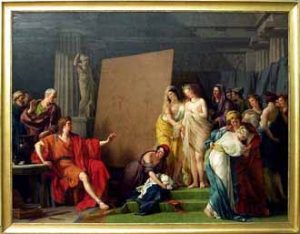
François-André Vincent: Zeuxis et les filles de Crotone, 1789, Musée du Louvre, inv. 8453.
According to Xenokrates, as handed down by Pliny, progress in art occurs in accordance with the criterion of mimesis, the imitation of reality. Thus does Pliny define the five best artists as the painters Apollodorus, Zeuxis, Parrhasius, Euphranor, and Apelles and the sculptors Phidias, Polyclitus, Myron, Pythagoras, and Lysippos. The apogee of art was attained by Alexander’s official artists, Apelles and Lysippos. Moreover, mimesis supplies the subject matter for numerous anecdotes reported by Pliny, in particular within the context of competitions among artists over the issue of realism: thus we have “Apelles’ horses” (35.95: real horses whinnied at the horses painted by Apelles, thereby earning him a victory over his rivals) and “Zeuxis’ grapes and Parrhasius’ curtain” (35.66: Zeuxis, having represented some grapes, gloried in the fact that some birds came to peck at the picture, but he admitted defeat when he himself was deceived by the curtain painted by his rival, which he took for a real curtain concealing the picture).
Roman Particularities and Moralism
And yet, even though he is dealing in the main with Greek art, Pliny no less offers a Roman view. As in the rest of his encyclopedia, his perspective is centered around Rome, and his work turns out to be an inventory taken from the standpoint and for the benefit of the Vrbs, of all that the Roman Empire contains and possesses. In the field of art (as in that of knowledge in general), Pliny strives to note the particularities of Roman practices, Rome not being the mere imitator of Greece. Thus, for statues, “the Greek practice is, not to cover any part of the body; while, on the contrary, the Roman and the military statues have the addition of a cuirass” (34.18). His history of art is also marked by a moralistic outlook that permeates the entire encyclopedia. This outlook is expressed through critical judgments about the attitude of emperors toward works of art: “The most celebrated of all the works, of which I have here spoken, have been dedicated, for some time past, by the Emperor Vespasianus in the Temple of Peace, and other public buildings of his. They had before been forcibly carried off by Nero, and brought to Rome, and arranged by him in the reception-rooms of his Golden Palace” (34.84). We also have this anecdote about Lysippos’ Apoxyomenos, which testifies to the people’s affection for works:
“Lysippus was most prolific in his works, and made more statues than any other artist. Among these, is the Man using the Body-scraper, which Marcus Agrippa had erected in front of his Warm Baths, and which wonderfully pleased the Emperor Tiberius. This prince, although in the beginning of his reign he imposed some restraint upon himself, could not resist the temptation, and had this statue removed to his bed-chamber, having substituted another for it at the baths: the people, however, were so resolutely opposed to this, that at the theater they clamourously demanded the Apoxyomenos to be replaced; and the prince, notwithstanding his attachment to it, was obliged to restore it” (34.62).
Greek Works and the Art Market in Rome
From the imperialistic perspective of the capital of the empire, Pliny endeavored to relate the fate of works as they moved between the Greek world and Rome: those works were brought over en masse by victorious generals in the name of the spoils of conquest (34.34: Rome took Volsinii in 265 for its 2,000 statues). Thus did they become the immense private and public collections that adorn the city of Rome. Pliny carefully lists these statues by the places where they were exhibited and by artists who made them, especially in Book 36, where Pliny copies down official lists established by the Roman administration. Such lists testify to a veritable citywide museography.
Beyond their nature as booty, works also became objects for purchase. Pliny provides here valuable testimony to the existence of a market for classical art. “At the same time, also, flourished Cydias; for whose picture of the Argonautae the orator Hortensius paid one hundred and forty-four thousand sesterces, and had a shrine constructed expressly for its reception on his estate at Tusculum” (35.130). Agrippa purchased an Ajax and a Venus for 1,200,000 sesterces from the inhabitants of Cyzicus (35.26). By way of comparison, in Pompeii one tunic was worth 15 sesterces and a liter of wine 1 sesterce.
Insisting on the properly Roman contribution to the development of art, Pliny recalls (35.22-23) that the price of works in Rome increased when victorious generals exhibited pictures representing the scenes of their battles. Thus, Messalla (consul in 263) was the first to exhibit in the Curia Hostilia, with the painting of his victory over Carthage in Sicily.
“The same thing was done, too, by L. Scipio, who placed in the Capitol a painting of the victory which he had gained in Asia; . . . Lucius Hostilius Mancinus, too, who had been the first to enter Carthage at the final attack, gave a very similar offence to Aemilianus, by exposing in the Forum a painting of that city and the attack upon it, he himself standing near the picture, and describing to the spectators the various details of the siege; a piece of complaisance which secured him the consulship at the ensuing Comitia.”
Conclusion
To sum up, Pliny constitutes our principal written source on ancient, and in particular Greek classical, art. His information on works, artists, and patterns of thinking about art have nourished knowledge of ancient art, but also artistic creativity and reflection on art starting with the Renaissance. Yet, far from being an impartial witness or a mere intermediary as regards lost works and texts (as had been thought for a very long time), Pliny situates his passages on the history of art within the general perspective of a Natural History that is centered on Rome and that is marked by imperialistic and moralistic attitudes. Here we have the contribution and main orientation of Pliny criticism today.
bibliographie
For the English translation: Pliny the Elder, The Natural History, trans. John Bostock and H. T. Riley, 1855: http://www.perseus.tufts.edu/hopper/text?doc=Plin.+Nat.+toc&redirect=true
We have used Gallimard’s L’univers des formes art history series: Naissance de l’art grec, Grèce archaïque, Grèce classique, Grèce hellénistique, L’Italie avant Rome, Rome, le centre du pouvoir, Rome, la fin de l’art antique.
Carey, Sorcha. Pliny’s Catalogue of Culture: Art and Empire in the Natural History. Oxford: Oxford University Press, 2003.
Chevallier, Raymond. L’artiste, le collectionneur, le faussaire. Pour une sociologie de l’art romain. Paris: A. Colin, 1991.
Hoffmann, Philippe and Paul-Louis Rinuy. Antiquités imaginaires. La référence antique dans l’art occidental de la Renaissance à nos jours. Paris: Presses de l’École normale supérieure, 1996.
Kris, Ernst and Otto Kurz. Legend, Myth, and Magic in the Image of the Artist: An Historical Experiment. New Haven and London: Yale University Press, 1979 (first German ed., 1934).
Naas, Valérie. Le projet encyclopédique de Pline l’Ancien. Rome: École Française de Rome, 2002.
Pommier, Édouard. Ed. Winckelmann: la naissance de l’histoire de l’art à l’époque des Lumières. Paris: La Documentation française, 1991.
_____. Ed. Histoire de l’histoire de l’art. Vol 1: De l’Antiquité au XVIIIe siècle. Paris: Louvre/Klincksieck, 1995.
_____. Winckelmann, inventeur de l’histoire de l’art. Paris: La Documentation française, 2003.
Reinach, Adolphe. Textes grecs et latins relatifs à l’histoire de la peinture ancienne. Recueil Milliet. Paris: Macula, 1985 (first ed. 1921).
Rouveret, Agnès. Histoire et imaginaire de la peinture ancienne. Rome: École Française de Rome, 1989.
Vasari, Giorgio. The Lives of the Artists. Trans. with an intro. and notes by Julia Conaway Bondanella and Peter Bondanella. Oxford and New York: Oxford University Press, 1998.
Les “Vies” d’artistes. Acts of the October 1-2, 1993 Louvre Colloquium. Paris: École Nationale Supérieure des Beaux-Arts, 1996.
Valérie Naas a former student at the École Normale Supérieure on the rue d’Ulm who has a teacher’s certificate in classical literature and a PhD., is presently an Assistant Professor of Latin Language and Literature at the University of Paris IV-Sorbonne. Her research work bears on Pliny the Elder’s Natural History, in particular the history of art and the history of knowledge and technical inventions. Indeed, this first century CE Roman encyclopedist constitutes the main written source on the history of ancient art. Naas has published Le projet encyclopédique de Pline l’Ancien (Rome: École Française de Rome, 2002), edited En-deçà et au-delà de la “ratio” (Lille: Collection UL3, 2004), and coedited Couleurs et matières dans l’Antiquité, textes, techniques et pratiques (Paris: Éditions rue d’Ulm, 2006). On these topics, she has also authored several articles (see: http://www.paris-sorbonne.fr/fr/spip.php?article8483) et talks (in particular at the French National Institute of Art History [INHA] and at the École du Louvre).
